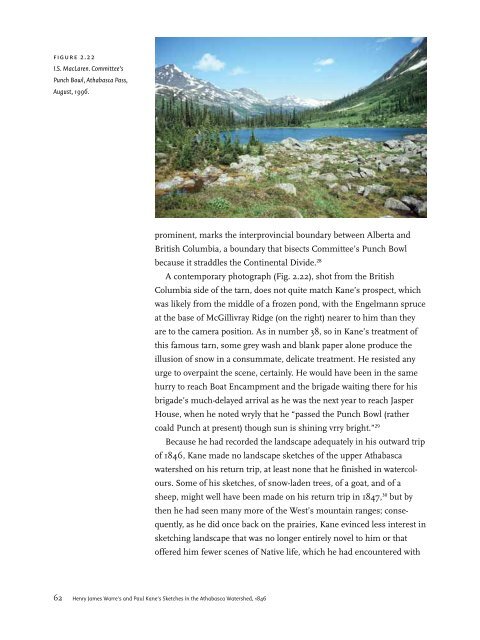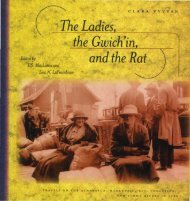figure 2.21<strong>Paul</strong> Kane, Committee’sPunch Bowl, <strong>Athabasca</strong>Pass, watercolour overgraphite on paper, 14.0x 22.9 cm, November1846; also known as TheCommittee’s Punch Bowl,Rocky Mounta<strong>in</strong>s.[Courtesy Royal Ontario Museum,946.15.239.]travel remote from one ano<strong>the</strong>r, not a few days apart. This is one of <strong>the</strong>most pa<strong>in</strong>terly sketches <strong>in</strong> <strong>the</strong> sequence, <strong>the</strong> horizontality of <strong>the</strong> Engelmannspruces seem<strong>in</strong>g to vie for space <strong>in</strong> a valley constricted by peakson each side <strong>and</strong> plugged with snow. The black of <strong>the</strong> creek makes itrace through <strong>the</strong> foreground, animat<strong>in</strong>g <strong>the</strong> picture plane quite wonderfully.Indeed, this sketch creates <strong>the</strong> liveliest foreground of any <strong>in</strong> <strong>the</strong><strong>Athabasca</strong> sequence.The west-<strong>and</strong>-north side of <strong>the</strong> Whirlpool River valley is dramaticallyhigh <strong>in</strong> number 38 (Fig. 2.20), but is not exaggerated. Possibly, part of itis represented aga<strong>in</strong> <strong>in</strong> number 39 (Fig. 2.21), <strong>the</strong> last <strong>in</strong> <strong>the</strong> sequencethat covers <strong>the</strong> upper <strong>Athabasca</strong> watershed. If so, number 38 must havebeen sketched at a po<strong>in</strong>t not far down <strong>the</strong> Whirlpool valley from <strong>the</strong> locationof number 39, which is known to be <strong>the</strong> south, or BritishColumbian, side of <strong>the</strong> tarn known as <strong>the</strong> Committee’s Punch Bowl.Kane identifies that location <strong>in</strong> his l<strong>and</strong>scape log. It is surpris<strong>in</strong>g that hedid not <strong>in</strong>clude <strong>the</strong> sketch <strong>in</strong> his exhibition <strong>in</strong> Toronto <strong>in</strong> 1848, for it wasa celebrated spot for fur traders travers<strong>in</strong>g <strong>Athabasca</strong> Portage: whe<strong>the</strong>rtravell<strong>in</strong>g east or west, one had a downhill route after Committee’sPunch Bowl. Named <strong>in</strong> 1824 by George Simpson, <strong>the</strong> firm’s <strong>in</strong>l<strong>and</strong>governor, for <strong>the</strong> London board of <strong>the</strong> Hudson’s Bay Company, <strong>the</strong> tarnoccupies <strong>the</strong> southwesternmost po<strong>in</strong>t of Jasper National Park, <strong>and</strong> <strong>the</strong>wall of mounta<strong>in</strong>s <strong>in</strong> <strong>the</strong> background, <strong>in</strong>clud<strong>in</strong>g Mallard Peak, <strong>the</strong> mostI . S . M a c L a r e n 61
figure 2.22I.S. MacLaren. Committee’sPunch Bowl, <strong>Athabasca</strong> Pass,August, 1996.prom<strong>in</strong>ent, marks <strong>the</strong> <strong>in</strong>terprov<strong>in</strong>cial boundary between Alberta <strong>and</strong>British Columbia, a boundary that bisects Committee’s Punch Bowlbecause it straddles <strong>the</strong> Cont<strong>in</strong>ental Divide. 28A contemporary photograph (Fig. 2.22), shot from <strong>the</strong> BritishColumbia side of <strong>the</strong> tarn, does not quite match Kane’s prospect, whichwas likely from <strong>the</strong> middle of a frozen pond, with <strong>the</strong> Engelmann spruceat <strong>the</strong> base of McGillivray Ridge (on <strong>the</strong> right) nearer to him than <strong>the</strong>yare to <strong>the</strong> camera position. As <strong>in</strong> number 38, so <strong>in</strong> Kane’s treatment ofthis famous tarn, some grey wash <strong>and</strong> blank paper alone produce <strong>the</strong>illusion of snow <strong>in</strong> a consummate, delicate treatment. He resisted anyurge to overpa<strong>in</strong>t <strong>the</strong> scene, certa<strong>in</strong>ly. He would have been <strong>in</strong> <strong>the</strong> samehurry to reach Boat Encampment <strong>and</strong> <strong>the</strong> brigade wait<strong>in</strong>g <strong>the</strong>re for hisbrigade’s much-delayed arrival as he was <strong>the</strong> next year to reach JasperHouse, when he noted wryly that he “passed <strong>the</strong> Punch Bowl (ra<strong>the</strong>rcoald Punch at present) though sun is sh<strong>in</strong><strong>in</strong>g vrry bright.” 29Because he had recorded <strong>the</strong> l<strong>and</strong>scape adequately <strong>in</strong> his outward tripof 1846, Kane made no l<strong>and</strong>scape sketches of <strong>the</strong> upper <strong>Athabasca</strong>watershed on his return trip, at least none that he f<strong>in</strong>ished <strong>in</strong> watercolours.Some of his sketches, of snow-laden trees, of a goat, <strong>and</strong> of asheep, might well have been made on his return trip <strong>in</strong> 1847, 30 but by<strong>the</strong>n he had seen many more of <strong>the</strong> West’s mounta<strong>in</strong> ranges; consequently,as he did once back on <strong>the</strong> prairies, Kane ev<strong>in</strong>ced less <strong>in</strong>terest <strong>in</strong>sketch<strong>in</strong>g l<strong>and</strong>scape that was no longer entirely novel to him or thatoffered him fewer scenes of Native life, which he had encountered with62 <strong>Henry</strong> <strong>James</strong> Warre’s <strong>and</strong> <strong>Paul</strong> Kane’s <strong>Sketches</strong> <strong>in</strong> <strong>the</strong> <strong>Athabasca</strong> Watershed, 1846
- Page 1 and 2: 1 The University of Alberta PressEd
- Page 3 and 4: Published byThe University of Alber
- Page 5 and 6: 7 Laying the Tracks for Tourism 233
- Page 7 and 8: figure 2.1Henry James Warre, RockyM
- Page 9: figure 2.3Henry James Warre,Jasper
- Page 13 and 14: figure 2.7Paul Kane, Jasper’s Lak
- Page 15 and 16: figure 2.9Paul Kane, AthabascaRiver
- Page 17 and 18: Solomon Creek (downriver) and Fiddl
- Page 19 and 20: the order in which he made the sket
- Page 21 and 22: figure 2.15I.S. MacLaren. Athabasca
- Page 23 and 24: of Kane’s sketch. The advantage o
- Page 25: figure 2.20Paul Kane, Snow Scene in
- Page 29 and 30: Appendix 1Kane’s Field Notes, 30
- Page 31 and 32: Author’s NoteI thank Bob Hallam a
- Page 33 and 34: subject to Jasper House. (The entry
- Page 35 and 36: 28. George Simpson, Fur Trade and E
- Page 37 and 38: Royal Ontario Museum: 92 ETH, 42-50
- Page 39 and 40: Canadian Congress on Leisure Resear
- Page 41 and 42: ———. Report of the Panel on t
- Page 43 and 44: 2: 82-140. London: Samuel Curtis, 1
- Page 45 and 46: Hart, E.J. Diamond Hitch: The Early
- Page 47 and 48: ———. A History of Canada’s
- Page 49 and 50: Nelson, J.G., and R.C. Scace, eds.
- Page 51 and 52: Speares, Betty. “Mary, Mary, Quit
















